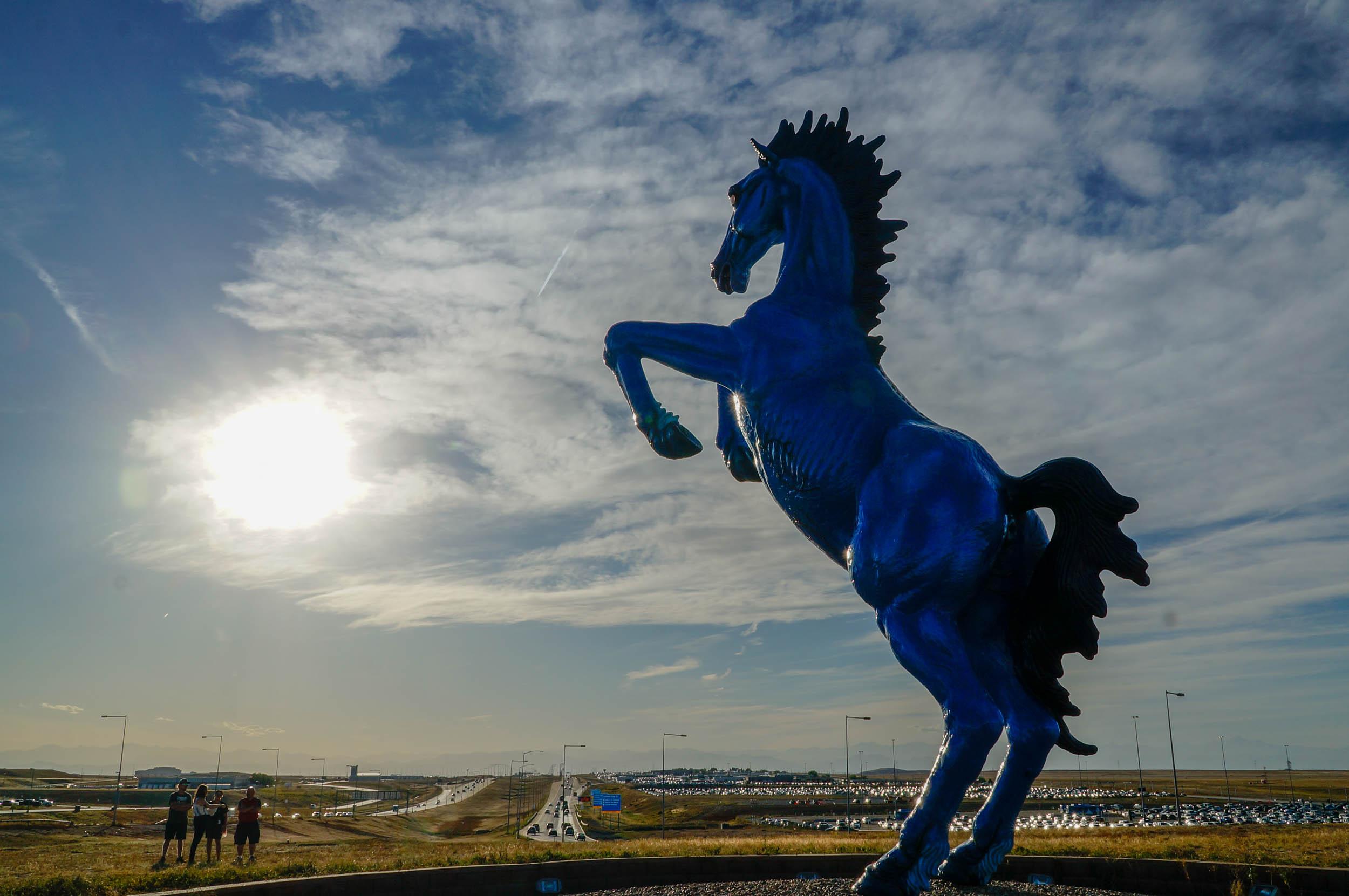
It’s hard to ignore the big blue horse that rears in a display of power and rebellion at Denver International Airport. The 32-foot-tall fiberglass sculpture towers over Peña Boulevard, its eyes glowing red at the cars whizzing by.
Denverites colloquially know this mighty equine as “Blucifer.” Some love it, some hate it, some love to hate it and many more are curious about it. Officially, the artwork’s name is “Mustang,” and the piece is a point of pride for the airport.
“We have this fierce blue mustang that we look at as kind of a protector of travelers, guarding this airport,” said Stacey Stegman, DIA’s senior vice president of communications, marketing and customer service.
The airport is thick with intrigue and rumor. Even if you look past the serious issues they’ve had lately with the reconstruction of the Great Hall, there’s a litany of conspiracy theories that say the outpost is home to Freemasons or a UFO hangar or that the terminal is a pictographic guide to the apocalypse. Well, in addition to the horse, there is a mural and gargoyle that might lend credence to that last one.
Adam Horst, of Aurora, thinks the sculpture is a fun, weird welcome to the state.
“The mustang is very Colorado,” he said, “and then it takes a hard left turn with the red eyes and the blue.”
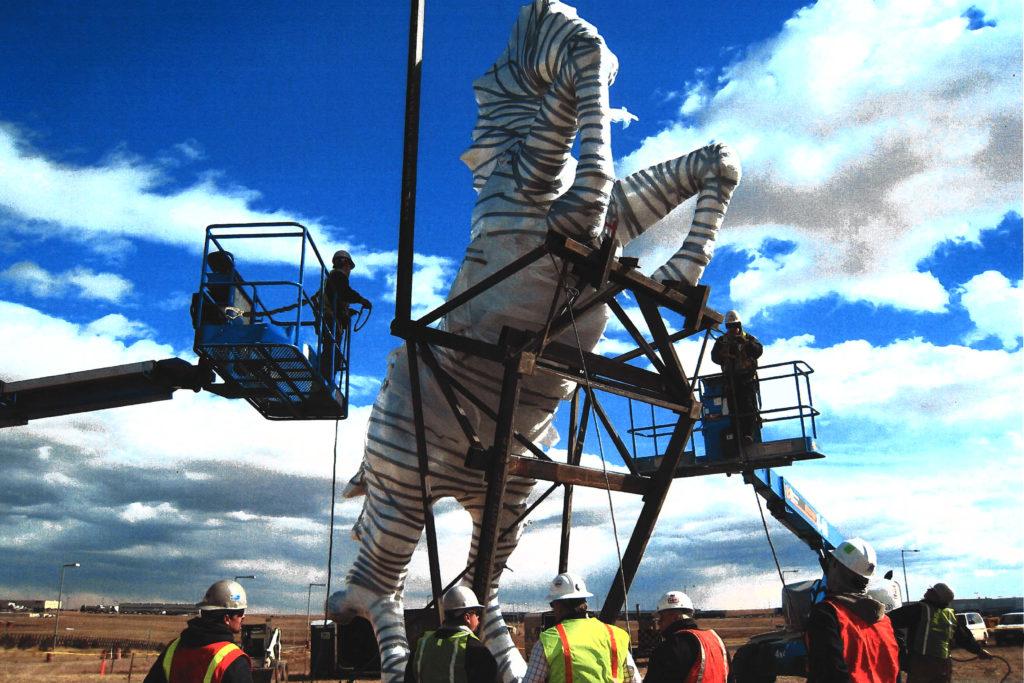
Is The Horse A Killer?
Horst wanted to know more about the inspiration that led New Mexico artist Luis Jiménez to create the stallion and “what exactly happened with the artist and the ultimate demise of him.”
The sculpture did kill its creator. That part is true. But is it cursed?
Luis Jiménez died in 2006 at 65, after a part of “Mustang” came loose while he was working on it. It severed an artery in his leg and he bled to death.
There are three main sections that make up the massive sculpture: the head, torso and hindquarter. And shortly before his passing, the artist had declared the head section done.
Jiménez’s studio later completed “Mustang” and installed it more than 15 years after it was commissioned — there had been a number of delays with the sculpture, which led to lawsuits. It made its debut on Feb. 11, 2008.
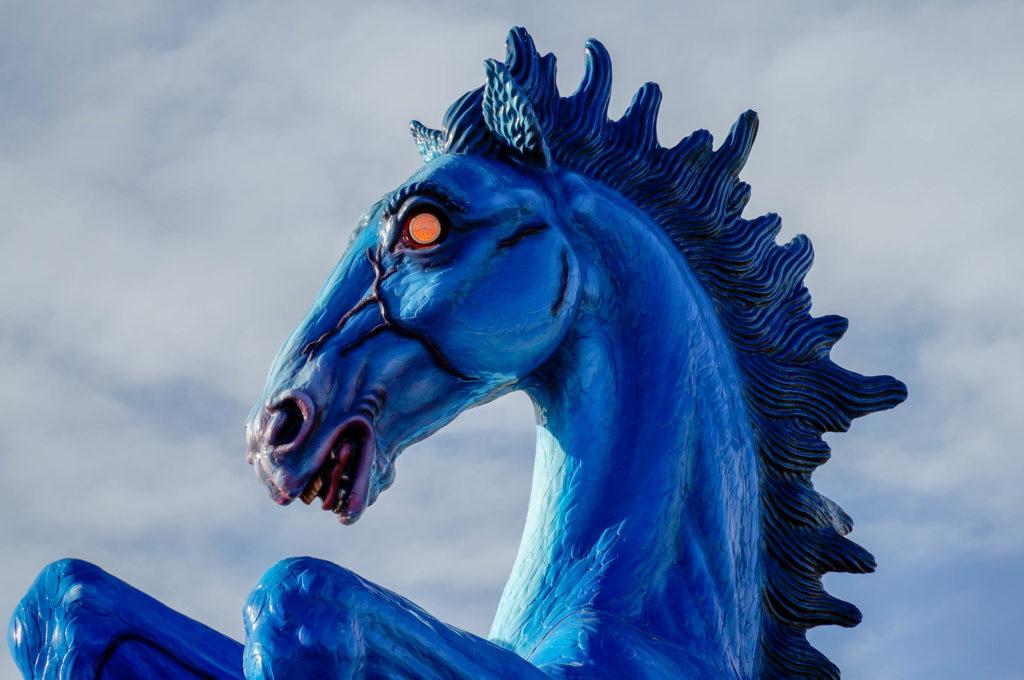
What’s With Those Eyes?
Horst wasn’t the only one with a question about “Mustang.” Michael “Gunner” Gunstanson, of Lakewood, wondered “who changes the light bulbs in the eyes of the big blue horse.”
No, they aren’t portals to perdition or even laser emitters. Turns out the eyes are LED flood lights. In the last seven years, the airport’s electrical team has only changed them just twice, Donohoe and her colleagues explained.
Those red eyes though, that people point to as evidence of Mustang’s demonic nature, are actually a tribute to the artist’s father.
Jiménez was born in El Paso, Texas in 1940. As a young child, he apprenticed at his father’s neon-sign shop. There he learned how to weld and paint.
His widow, Susan Jiménez, said he often told stories about working alongside his dad, how he would come home, his hands marred by the work.
His father would say “This is how he learns,” Susan said. “So he grew up with this strong tradition of working with his hands.”
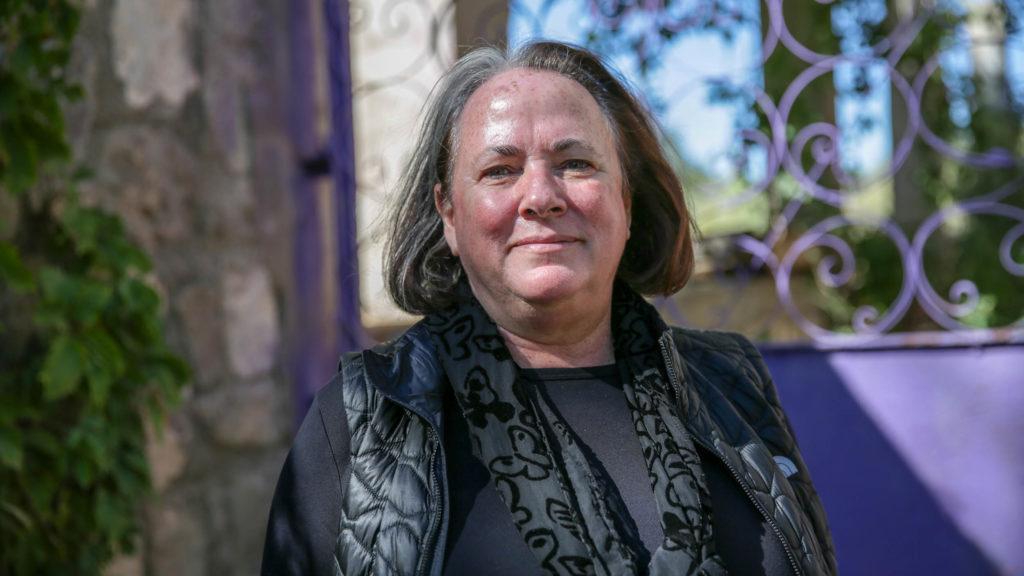
Luis Jiménez studied architecture and, then, fine art at the University of Texas. He spent time honing his skills in Mexico City and New York. But working with his hands remained a huge part of his process, even as he began experimenting with fiberglass in the 60s.
“I was trying to keep the process I used as close to the industrial process as possible because I felt it was, for lack of a better term, maybe a blue-collar process,” he said in a video for the Smithsonian American Art Museum in D.C. which has a number of his works including a cowboy riding a blue bucking horse. “I didn’t want to go for that art process.”
Susan understands that the “eyes have been a point of focus.” She remembers a time Luis was home alone at night. He heard something in the living room and went to investigate.
“He sees these two eyes,” she said. “And he said the hairs on the back of his neck stood up.”
He had thought there was an invader in their home, but then felt a nudge from a familiar source. It was their horse Black Jack, the model for Luis’ final work, who had mysteriously broken into their living room.
“And so [do the eyes] have anything to do with that incident and this kind of you're afraid of something but then it’s OK [because you realize] it is familiar,” she said. “I don't know. But the eyes do not have any evil intent whatsoever.”
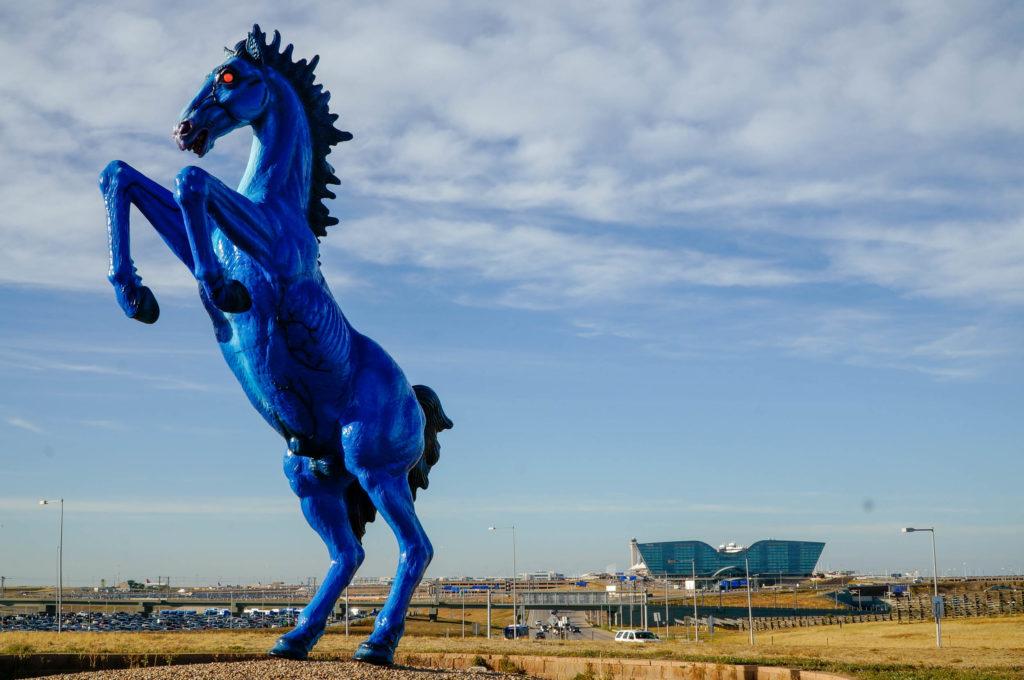
Why So Very Blue?
Jiménez was masterful with his colors said Dale Kronkright, head of conservation at the Georgia O'Keeffe Museum in Santa Fe, New Mexico.
“There was no surface on any Luis Jiménez sculpture that was ever any less than six different colors, each airbrushed separately adding a slightly different tone,” he said.
Kronkright worked on the preservation and conservation of a number of Jiménez’ sculptures, including “Mustang.” The artist often included flake, that glittery quality you see on lowrider cars, in his sculptures.
Some critics found his too flashy. But others saw his brightly colored, shimmering art as a symbol of the Chicano and working class experience in the American West, a nod to his own heritage. Kronkright sees that in “Mustang,” which he thinks is brilliant.
“My takeaway from Mustang is defiance, this absolute expression of identity, having a place, standing strong, being fiery, being gigantic,” Kronkright said.
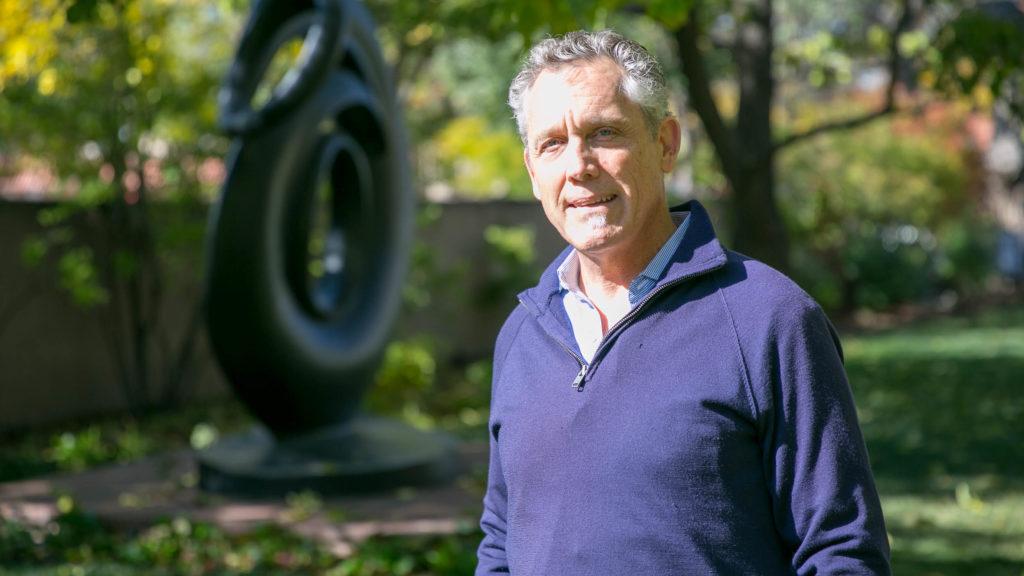
The gigantic part proved to be an engineering challenge for Jiménez though. It was the largest work he had done. Kronkright recalls a phone conversation where his friend and colleague talked about the sculpture’s progress.
“He said, ‘You know, this work is gonna kill me,’” Kronkright said. “And that was just this, at the time, humorous comment about how exhausting it was trying to figure out the engineering.”
Susan Jiménez, who now oversees her late husband’s estate, said it was important to finish “Mustang,” using the paint formulas her late husband left behind.
“It was his life's work,” she said. “He was a mature artist at that point. He got the commission in 92. And it was years of living with this sculpture.”
Some of the early sketches had “Mustang” as yellow, even pink. But Luis decided on blue, modeling it after Black Jack, who happened to be a blue Appaloosa.
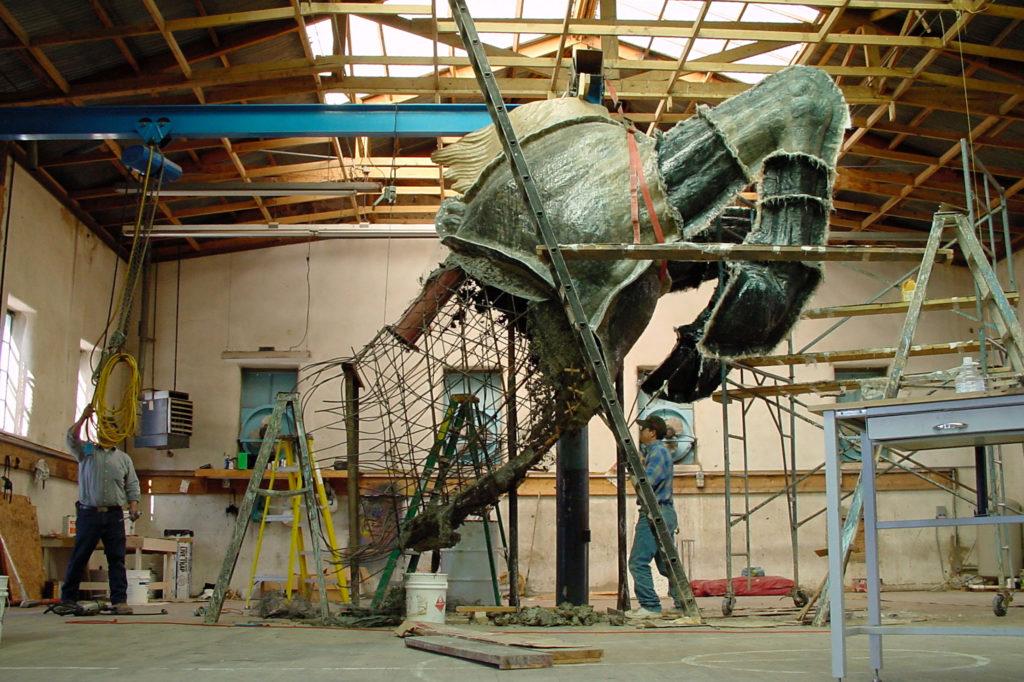
Has The Public Ever Dared To Stand Against It?
The striking blue color and glowing red eyes were controversial from the start. There was even a Facebook page called "DIA’s Heinous Blue Mustang Has Got to Go.” As the old adage goes though, all news is good news if they’re paying attention to you. And DIA public art manager Colleen Donohoe appreciates that people still talk about the artwork.
“There’s a number of public art collections that people don’t talk about, so we’re lucky to have that aspect,” she said. “But we see him as more than that.”
The airport continues to hear from people for and against “Mustang.” Those critical of the artwork say stuff like “he scares our children” or “you should paint him orange like the Broncos.”
The airport’s public art policy stresses that artwork remain in public view for at least five years after its install. That date has long come and gone.
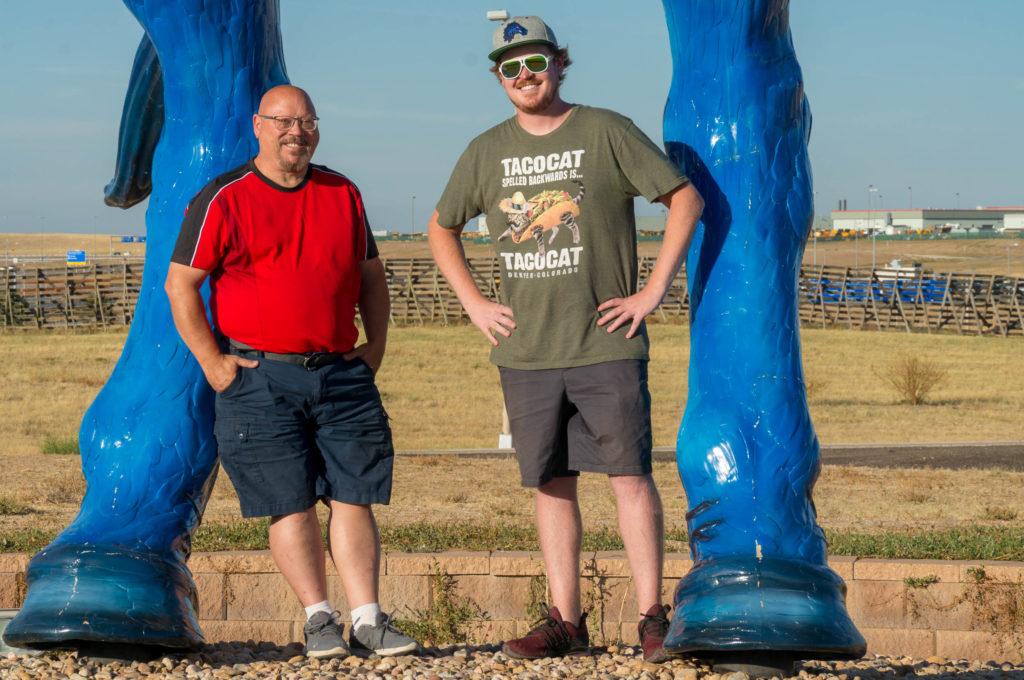
The sculpture has not only withstood public scrutiny, but it’s also had to hold up against rain, hail, intense wind — conservators say its spot outside the airport is an extreme environment for artwork — and, for the first time, spray paint. A vandal recently dared to spray graffiti on the horse’s lower legs. The airport was able to have it removed without damage. Denver insures the sculptural steed for $2 million, according to the finance department, to ensure it continues to weather the elements.
DIA’s Stacey Stegman thinks there would now be a public outcry if the airport did do anything to “Mustang.”
Michael Gunstanson said he’d “lead the charge on that.”
“You and I will lay on the ground together,” came Stegman’s response. “We’ll chain ourselves to Mustang and he’s not going anywhere.”









